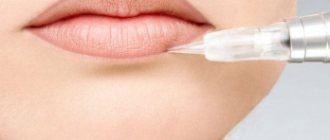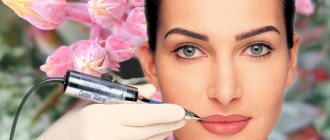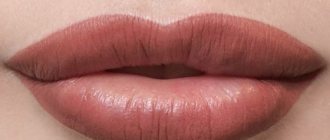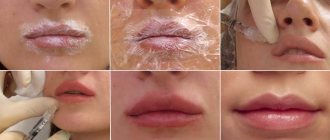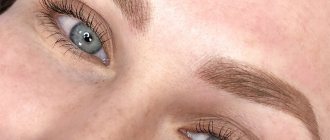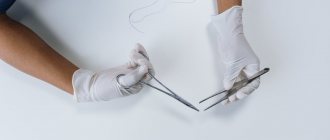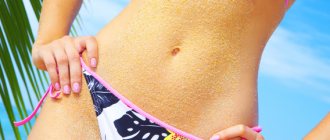Date of publication: 08/30/2017 9151
The healing time for lips after tattooing is highly individual. The skin recovers on average in 5-7 days. And about three more weeks are required for complete cell restoration. How long and comfortable the rehabilitation will be after applying permanent makeup is directly affected by how much proper lip care is provided.
We start care with preparation
The process of transforming your lips begins with the decision to undergo permanent makeup. At this point, you should begin the preparatory period in order to avoid many unpleasant surprises later.
- Since the master works with dyes, it is necessary to test for allergies to any of the dye pigments.
- 5-7 days before tattooing, honey or salt scrubs are applied to the skin of the lips to remove dead cells.
- Active humidification is carried out. To do this, you can use lip balm or baby cream.
- It is advisable to take a course of antiviral drugs within a week. This will strengthen your immune system and help prevent the spread of infection if you become infected.
Carrying out good preparatory work will help the skin recover faster and achieve better results after tattooing.
Consequences
However, even if you follow all the care recommendations when performing tattooing at home, in some cases it is not possible to avoid negative consequences, for example, the appearance of herpes. According to statistics, approximately 7% of women who have not previously suffered from this disease experience signs of herpes after tattooing.
Therefore, a week before the procedure, to reduce the likelihood of viral rashes, you should take anti-herpes medications (acyclovir, herpevir, famvir).
Negative consequences after lip tattooing that occur due to improper makeup technique include the appearance of bruises. Bruises form if blood vessels are damaged during the process. This unpleasant effect from tattooing at home will go away in about 5-6 days and will not affect the final result of the procedure in any way.
The main principles of proper lip tattoo care
The procedure for treating lip skin after permanent makeup includes 4 main steps:
- Washing. In the first 2-3 days, contact with water must be avoided, as this is the main carrier of microbes that can directly enter the body through the damaged dermis of the lips. Then, for 5-6 days, you should use only boiled water for washing. You should not wipe your face with a towel. To remove moisture, gently blot the lip tattoo area. Washing with soap is strictly prohibited. To do this, use hypoallergenic foam or gels with neutral pH.
- Disinfection. Until the crusts completely fall off, be sure to disinfect with antimicrobial agents. Treatment is carried out 3-4 times a day. Disinfection is carried out with soft, smooth movements, carefully wetting the entire surface.
- Applying cream. I treat the area where permanent makeup is applied with cream. They relieve redness, remove swelling, and accelerate the regenerative process. The cream is applied in a small layer. The use of the cream is adjusted as the drug is absorbed into the skin. Do not allow it to dry out or crack. The following are used as healing ointments: Vaseline, Depanthenol, Hydrocartisone, Actovegin.
- Hygienic treatment. Taking good care of your skin and using skincare moisturizers will keep your lips beautiful and healthy. In the summer, they use products with protective substances against ultraviolet radiation; in the winter, they use hygienic lipstick to protect themselves from low temperatures and chapping. The use of toothpaste requires special care; care must be taken to ensure that the paste does not come into contact with pigmented skin.
For additional protection against the occurrence of herpes, the tattoo area is treated with antiviral drugs: Acyclovir, Zovirax.
What products are used for care
For care you need professional-level cosmetic treatments, not decorative cosmetics. Among the medications prescribed by doctors after permanent makeup are the following.
| Nomination | Place | Name | Price |
| What products are used for care | 1 | Nutritic Lips, La Roche-Posay | 840 ₽ |
| 2 | Buttermask for Lips, Kiehl's | 2 300 ₽ | |
| 3 | Laneige Lip Sleeping Mask | 370 ₽ | |
| 4 | Cicaplast Lips, La Roche-Posay | 530 ₽ |
Nutritic Lips, La Roche-Posay
Rating: 4.9
Balm from France is intended for dry, rough skin and chapped lips. Suitable for women with particularly sensitive skin. Provides intense hydration, softness, and makes lips soft. When applied, it does not leave a shiny film, there is no sticky effect. Additionally protects delicate skin from cold.
Thanks to shea butter, the process of replacing old cells with new ones accelerates. Vitamin E gives elasticity. Biolipids eliminate skin dehydration.
Buttermask for Lips, Kiehl's
Rating: 4.9
This is an overnight mask. It has a powerful restorative effect, since it lasts 6-8 hours while a person sleeps. Contains mango butter to smooth out wrinkled lips. The second component is coconut oil. It is saturated with fatty acids, so it nourishes the skin, making the epidermis soft and tender.
Laneige Lip Sleeping Mask
Rating: 4.8
The overnight mask contains beta-glucan minerals. They form a dense, moist film on the surface of the epidermis and saturate the lips with moisture throughout the night. The composition includes a complex of extracts from 4 berries, thanks to which the skin replenishes its supply of vitamins, becomes elastic and smooth. The mask is applied in a thick layer before bedtime and removed with a napkin in the morning. Dead cells are removed along with it.
Cicaplast Lips, La Roche-Posay
Rating: 4.8
The cosmetic product is used after tattooing for accelerated regeneration and protection. Shea butter replenishes the skin's mantle and eliminates irritation. MP lipids create a durable protective layer that prevents bacteria from penetrating wounds. Due to numerous punctures with a needle, the skin becomes very inflamed, and panthenol immediately has a calming effect. There are no parabens or fragrances in the composition, which means there will be no allergic reaction on sensitive lips.
Features of care in the first days
In the first days, the lips will become swollen and swelling will appear. This is a normal reaction of the body to multiple micropunctures and damage to the skin. There is no need to be afraid in this situation.
A cosmetologist performing permanent makeup will treat the skin with disinfectants and apply a healing ointment. Panthenol or Bepanten are most often used. Next, the lingerist will advise you on the rules of lip care and recommend medications that will help with rapid healing and restoration of the skin.
Disinfectants are applied each time before applying the healing ointment. These products must be used for 7-10 days. Miramistin or another agent is chosen as a disinfectant. It is important that the drug does not contain alcohol. The use of healing and antimicrobial agents will protect against infection and help the skin recover faster.
How is healing going?
Immediately after the procedure, the treatment area swells. Over time, the swelling subsides on its own. It does not cause significant discomfort. Clients also report moderate pain. The specialist will recommend an anesthetic drug to relieve it. In the first day, in addition, numbness of the lips may persist. This is due to the use of an anesthetic drug.
On the second day, the numbness disappears, the pain weakens, and the swelling begins to subside. By the third day, lips may itch and peel.
First week care
During the first 7 days, caring procedures must be carried out thoroughly, in compliance with all the recommendations of the cosmetologist. As such, no special actions are required, but it is important not to give up carrying out the procedures.
- By 4-5 days the swelling should go away. The process of restoration of dermal cells and healing of wounds begins. This process is accompanied by itching and the formation of a dense crust. It is strictly forbidden to comb the tattoo site and mechanically remove scabs.
- On days 6-7, the crusts begin to peel off and the skin becomes very sensitive. During this period, it is important to protect the dermis of the lips from drying out. You should constantly lubricate your lips with balm or healing cream. After the crusts fall off, a thin film of young skin appears in their place, because of this the color becomes less bright and takes on a natural shade.
After a week, the lips acquire the correct shape and have a natural shade. But this does not mean that lip care is no longer required. During this period, many girls make a big mistake, thinking that the process is completed.
On days 7-10, lips continue to be smeared with restorative cream, but in smaller quantities, 1-2 times a day is enough.
The final restoration of the skin will occur in a month. The color will finally appear and the outline of the lips will reach its final phase.
How long does it take for skin to heal?
It is difficult to say exactly how many days it takes for a tattoo to heal, as it depends on many factors:
- Depth of pigment introduction. The deeper the artist injected the dye under the skin, the longer the recovery period will last. The same dependence is with the amount of pigment. The result of the contour technique will heal faster than the result of the 3D method, since in the first case much less pigment was used, due to the fact that in the contour technique only the contour of the lips is outlined.
- Having herpes. This problem will increase the healing time of the lips, since inflammation will not allow a crust to form and fall off quickly. To speed up or avoid herpes, you need to use antiviral drugs in the lip area.
- Your compliance with the instructions and tattoo care instructions that the artist prescribed for you after completing the procedure. Follow the directions to see results faster.
The standard healing time for damaged skin is 20 days. But in individual cases it can increase to a month, or decrease to two weeks.
In the first week, the skin changes, then it heals on its own. This is not visible to the girl, but the lips are recovering from damage, healing ointments can contribute to this, the woman herself should take care of this.
Unseen circumstances
If you see that the recovery process is being delayed or there are serious deviations from the norm, urgent measures are required. If swelling and redness do not go away after 4-5 days, you should consult a doctor.
Most often, this situation is caused by an allergic reaction to the dye. Then the dermatologist will prescribe antihistamines and indicate what remedies can be used to eliminate the symptoms. Most often prescribed are Suprastin, Tavegil and other allergy medications. For topical use, use Hydrocartisone ointment. Cold compresses are used as an additional remedy for swelling.
In cases where redness and pain do not go away, it is necessary to get tested for infection. If infection occurs, more serious treatment with antibacterial drugs will be required.
Against the background of reduced immunity, herpes can develop in areas of the damaged layer of the dermis of the lips. Preventive measures will help counteract the development of the virus. To do this, during the first 7 days they take antiviral drugs: Gerpevir, Acyclovir, Valtrex and others. While the healing process is underway, the course must be continued. If manifestations of herpes become noticeable before tattooing, reschedule the procedure until the virus is eliminated. You should not self-medicate; be sure to consult a doctor for qualified advice. The doctor will be able to choose a treatment that will not reduce pigmentation.
How to make a tattoo
Tattooing is a complex and responsible procedure, the effect of which directly depends not only on the availability of the necessary professional equipment and material, but also on the professionalism of the artist.
How is lip tattoo done?
There are many different techniques for lip tattooing. But in all cases, the procedure consists of six stages:
- lips are cleaned of cosmetics and disinfected with an antiseptic;
- the mouth is covered with a special cream, which is distinguished by its analgesic effect;
- disinfect the skin;
- using a tattoo machine equipped with a sterile needle, contour lines are applied;
- using tools of different diameters, carefully pigment the remaining unpainted areas;
- at the end of the procedure, the treated area is wiped again with a sterile napkin and an ointment that has a pronounced anti-inflammatory effect is applied to the treated areas.
How is eyebrow tattooing done?
The eyebrow tattoo procedure consists of a number of stages:
- The master and the client select the shape of the eyebrows.
- The eyebrow area is treated with antibacterial soap, after which the areas are wiped with an antiseptic substance.
- A weak color pattern is applied.
- The tone is gradually enhanced by dark pigment to the optimal limit.
- In chipped areas, the skin is disinfected.
- The treated areas are lubricated with a wound-healing cream, which will not allow dust to enter the treated area.
- Eyebrows are corrected. This procedure is carried out only after the crust has come off after the first stage of tattooing.
How to care for lips when crusts appear
On the 3-4th day after permanent tattooing of the lips, crusts begin to form, itching and dry skin are felt. The resulting crusts cannot be picked out or removed mechanically; they must fall off on their own. The uniform distribution of pigment over the entire area of the lips, as well as the durability of the result, depends on this. If you scratch along with the crust, part of the added pigment is removed, then the color in these places will be less saturated, in some cases scars may remain.
In order for the crusts to come off easier and faster, proper care is necessary. To do this you will need:
- daily application of healing ointment in a thin layer;
- limit contact with water;
- carry out constant disinfection;
- do not lick or bite your lips.
After a few days, with proper care, the scabs will fall off on their own, and you will be able to see the preliminary result of the tattoo.
Types of permanent makeup and lip skin condition
Let’s briefly touch on the procedure of lip tattooing and its types in order to understand the condition of the skin. You can read about this in more detail.
The process is performed in the following sequence:
- The skin of the lips is cleansed of all cosmetics, fat, and exfoliation.
- Local anesthesia is administered (using creams or ampoules and a syringe).
- The master, using a machine with a replaceable disposable needle, makes punctures through which pigment penetrates under the epidermis.
- First, a dotted outline is made to indicate the general line. Then, depending on the type of permanent makeup, the remaining area of the lips is processed.
The procedure lasts 2-3 hours. It can be one-time or may require 2-4 visits over 3 months (in cases of complex shape adjustment using 3D effects). The pigment stays under the epidermis for 2-3 years, which depends on the patient’s age and the speed of metabolic processes. The higher they are (usually in young people), the faster the paint is removed by the body and the need for re-application. In fact, this is a micro-operation, so you should take lip tattooing seriously and take a responsible approach to the rules of skin care after the procedure.
Types of lip tattoo
How much the skin will be injured and how long it will take to heal depends on the type of permanent makeup. It is divided into:
- Contour stroke.
It is carried out using a pigment similar in color to the shade of the lips themselves. The contour line helps to make the mouth more expressive, correct the shape a little, and smooth out differences. Most often, this technique is used in combination with other types of tattooing.
- Contour stroke with shading
. The injected pigment is spread from the contour to the middle of the lips by 1/3 of the area. This evens out the contour, corrects uneven shape (elevation of one edge), and the lips look juicier.
- Outlining and filling the entire area of the lips with pigment.
This is called full shading. The contour and entire surface of the lips are treated with one pigment, sometimes two, similar in tone. This type of tattoo adds volume, brightness, and plumpness.
- Naturel
. Tattooing is carried out using a nude palette, does not radically affect the shape, and ensures expressiveness and brightness of the lips.
- Deep tattoo
. A pigment of one shade is mechanically applied to a greater depth over the entire area. Lips look bright, full, rich. Extends the effect of tattooing up to 4 years.
- 3D.
3-4 colors are used, smoothly transitioning from one to another. The edges are made darker, and towards the middle they become lighter, shading the previous colors. Visually, this completely changes the shape and corrects drooping corners of the mouth due to age-related changes. Lips become juicy and visually increase in size.
- Powder spraying
. Performed without a rigid contour. The pigment is introduced only under the main surface. Light colors are used. The technique is suitable for those who are satisfied with the shape of their lips, but want to make them noticeably voluminous while maintaining naturalness.
The more pigment is applied under the skin during tattooing, the higher the lip injury. Accordingly, the recovery process increases.
How do patients feel after tattooing?
Since this is a micro-surgery, when the anesthesia wears off, the lips begin to hurt. It hurts to speak, just to open your mouth. This is normal, but it’s important to consider that if your job involves speaking, take a day off or a mini-vacation.
When performing permanent makeup, the master makes hundreds of punctures of the epidermis. Mechanical damage to the skin leads to inflammation. The lips and the areas around them will swell and become noticeably larger than before. There is no need to be scared - it will go away as it heals and is taken care of. You can read about what serious complications are possible after tattooing.
In 30-50% of cases, inflammation is accompanied by infection. Most often herpes. Therefore, even before the procedure, they begin to take antiviral drugs (2-3 days before). The body begins to heal punctures in the epidermis by producing platelets. Crusts form on the surface of the skin. There is a feeling of tightness and itching. Then the crusts will begin to peel off and the skin will itch. The appearance of swollen, hanging crusts is not the most attractive, but underneath them natural new skin with added pigment will already be visible.
What to do with swelling
In the first days after the permanent lip makeup procedure, obvious swelling is visible. This is the body's reaction to damage to the integrity of the skin. The swelling will go away on its own in a couple of days. If the swelling is severe, use a few tips to eliminate it:
- Take an anti-allergenic drug.
- Apply a thin layer of hydrocortisone ointment for several days.
- Apply cold compresses based on herbal infusions and ice, wrapped in a sterile bandage or clean cloth.
If the swelling remains, consult a doctor; there may be an infection. In this case, drug treatment will be required.
At home
Lip tattooing done at home has a number of advantages over the procedure offered in beauty salons:
- Possibility of choosing a makeup palette that matches your appearance. Beauty salons use a standard set of tattoo inks.
- A more responsible attitude of the master to work, who needs to develop his own client base without relying on advertising and the status of the salon.
- Comfortable environment of your own home.
After full recovery
Typically, healing and full effect occurs after 25-28 days. Upon completion of the restoration process, it is recommended to visit your specialist to inspect the result. The cosmetologist will examine the surface of the lips and give further recommendations. Correction of uneven pigmentation or additional skin care products may be required. At the end of the month, the skin is completely restored, the pigmentation takes on its final appearance and the result can be analyzed.
To consolidate the effect, cosmetologists recommend continuing to use lip moisturizers, as well as sunscreens with high UV resistance.
You can also pay attention to our services: Lip tattoo with shading, Lip tattoo 3d effect
What absolutely should not be done after lip tattooing
A cosmetologist who performs permanent makeup issues a memo with a list of restrictions. Violating the instructions will prolong the healing process, reduce the effect of the tattoo, or even ruin the result. Here are some basic tips on what not to do:
- Lick your lips with your tongue or wet them.
- Use scrubs and peels.
- Touch them with dirty hands.
- Smoking (mechanical squeezing of a cigarette while inhaling harms the subcutaneous pigment).
- Eat cold or hot food.
- Peel off dried crusts.
- Visit bathhouses and swimming pools (your lips will steam and get wet).
It is also not recommended to engage in active sports (it increases metabolism, the pigment will not “settle” in place, but will be partially removed).
Crust formation
On the third day after the tattoo, crusts form on the lips. Along with this, an unpleasant itching is felt. During this period, you should not comb or tear off the skin. Otherwise, scars will form and the pigment will remain uneven. The healing process should take place as naturally as possible, without physical or drug intervention. The crusts will come off on their own.
There are cases when crusts do not form during the healing process. This is affected by several situations:
- The tattoo was done incorrectly. The needle didn't go deep enough, so there was no discharge that should have dried up.
- Salon care for permanent makeup. Today, masters offer regular removal of lymph with special ointments. Cell regeneration is quick and painless. The tattoo remains bright, and the lips look healthy already on the 3rd day.
Recovery after permanent surgery is an individual process, depending on the female body. However, proper care ensures rapid healing even in severe cases.
